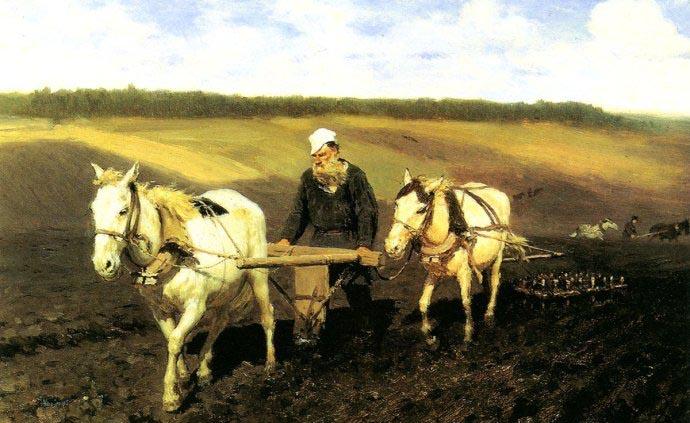2021/9/27

Tolstoy in The Arable Land, 1887 Oil on canvas, 27.8x40.3cm, < Russian > Repin, Collection of the Trechakov Museum of Fine Arts in Moscow
This is a portrait of to Tolstoy by the painter Repin. In the distant view, the pale blue sky was floating with floating clouds, casting light and shadow on the slope, two white horses were carrying heavy loads and pulling farm tools, Tolstoy looked attentive, and the wooden plough walked between the two horses, most of the cultivated land had been ploughed, turning out the fertile black soil, and another farmer in the distance was also plowing the ground. Immersed in the breath and light of the earth, everything is harmonized with the subtle colors, and the whole picture is full of vitality and vitality.
At the age of 73, Tolstoy returned to the manor left by his mother in his hometown of Yasnaya Polyana, and Repin often visited him at the manor to see Tolstoy in the farmland for several hours without stopping to plough the black soil, and trying to help the plough but unable to move. Repin prepared the painting for three months, hiding in a trench every day, hiding in a bush on the edge of the ditch to secretly observe Tolstoy's ploughing fields.
The close contact between the great Russian painter Repin and the great writer Lev Tolstoy, from 1880 to 1910 Leo Tolstoy's death, lasted about 30 years, Repin painted more than seventy sketches for Tolstoy, including oil paintings, watercolors, drawings and sculptures, his tolstoy is very vivid, both sketches and oil paintings of ploughed fields, as well as depictions of living conditions in writing, on benches, and on sick beds, faithfully recording the normality of literary masters, without Mannerisms, All impetuosity and distractions were abandoned. They often exchanged visits, exchanged letters, exchanged ideas, and also discussed issues in artistic creation.
In his later years, Tolstoy's view of the manor changed a lot, and he began to pay attention to the hard-working peasants, and the poor peasants made Tolstoy feel uneasy and remorseful. In order to alleviate his guilt, Tolstoy began to change his lifestyle, simplifying his personal life as much as possible: disgusted with sophistication and socializing between relatives and friends, refusing to attend the banquets of the nobility, eating vegetarian, quit smoking, abandoning his favorite hunting, often wearing a straw hat, wearing a coarse cloth blouse, stepping on bark shoes, working in the fields, so that farm work was proficient. Spirit guides action, labor cultivates a strong spirit, and manual labor is noble and beneficial, as Tolstoy confirmed with his own actions.
Author: I. Yefimovich Repin E· Repin 1844-1930)
列宾(I· E· Repin 1844-1930)
The greatest Russian realist painter of the late 19th century, an important representative of the itinerant exhibition school. Born on July 24, 1844 in the town of Chuguev in Chuguev Province, Ukraine, he studied iconography with icon painters in his early years, entered the Royal Academy of Fine Arts in 1864, from 1873 to 1876, Repin received an allowance from the Academy of Fine Arts, successively went to Italy and France to study European classical and modern art, and after returning to China in 1876, he painted diligently, insisted on sketching in the countryside and folk, and maintained close contacts with revolutionary democratic intellectuals, creating a large number of historical paintings, genre paintings and portraits. It shows the poverty and suffering of the people and the desire for a better life. He paid attention to the events of Russian history and created many paintings on historical subjects. In 1878, he joined the Society of Traveling Exhibition Artists, and has since devoted himself to the creation of peasant themes. After the October Revolution of 1917, the outskirts of St. Petersburg, where Repin lived, were annexed to Finland, and Lenin and Voroshilov graciously invited him to return to Finland, but he was in his old age, frail and sick, and died on September 29, 1930 in Kuorkara, Finland.
Representative works:
"The Porter on the Volga", "The Propagandist Arrested", "Refusal to Confess", "The Unexpected Return", "Tolstoy"
"Reply of the Zaporos to the Sultan of Turkey", "Ivan the Terrible and his son killed by him on November 16, 1581", "Princess Sophia", "Reply of the Zaporos to the Sultan of Turkey", etc.